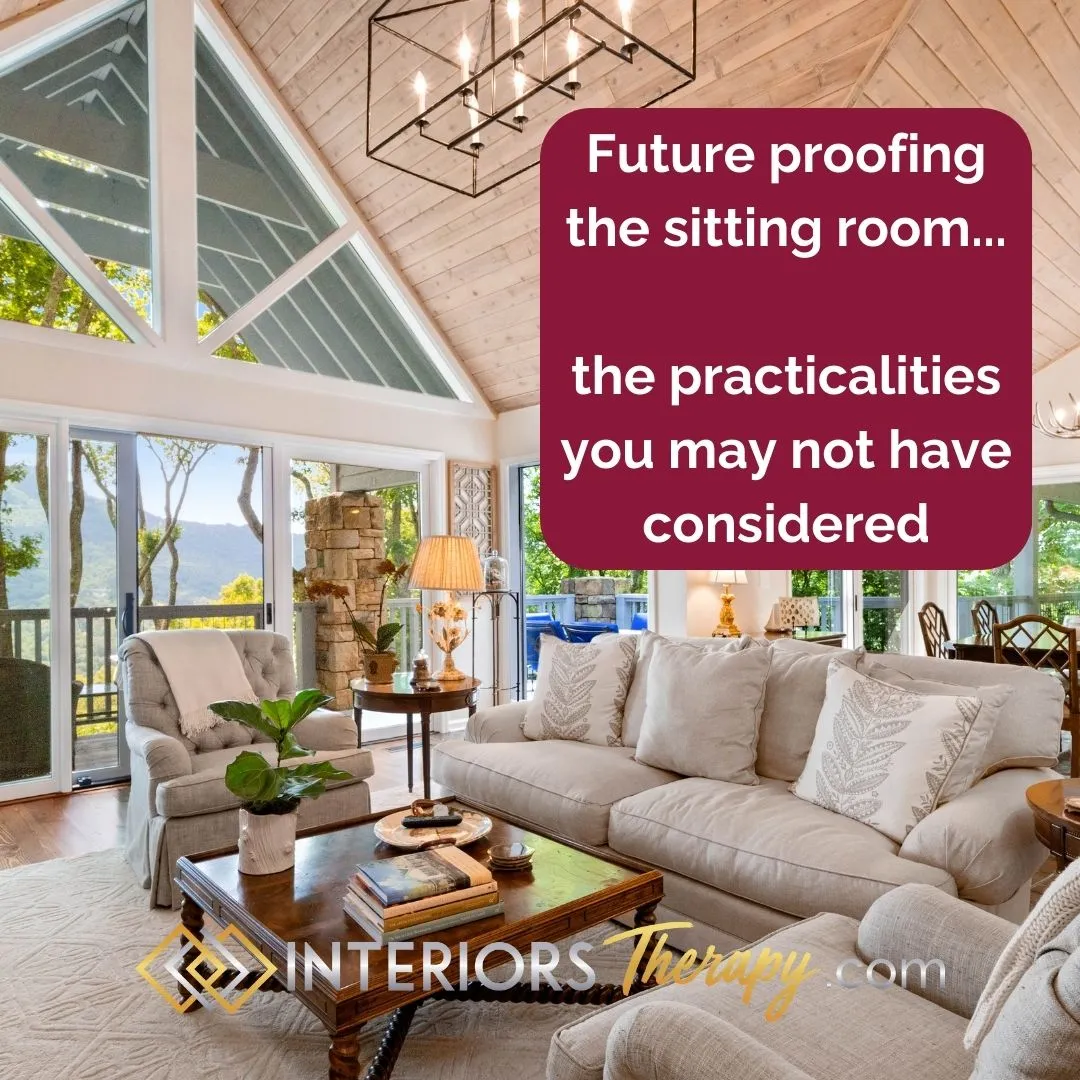Future Proofing the Sitting Room

Why creating a practical space now could save you a whole heap of inconvenience later
This article was written for an over 50's Blog, and I wanted to share it here also as it's relevant for anyone planning a major revamp of their living space..
Suzanne Roynon, a highly regarded Interiors Therapist and author at www.interiorstherapy.com encourages her clients to consider everything they are keeping in their living rooms to ensure they are positive and rewarding spaces to spend time in.
“Do I need it, do I use it, do I love it? Is at the basis of every consultation” she explains. “With each year we inevitably attract more memories, gifts and possessions which are kept and often displayed through obligation rather than any real pleasure in the item itself.
The fabulous thing about being over 50 is that none of us are required to keep anything which doesn’t add to our lives or because someone else expects us to do so. There’s still a lot of life to enjoy, and being weighed down by the past is a choice none of us, with the possible exception of King Charles, are compelled to make.”
When it comes to arranging bookcases/storage units, what should you bear in mind? Where should these ideally go? What should you be careful to avoid when arranging these items? Particularly if you are older?
I’m going to say something slightly controversial about bookshelves and for those of us who grew up cherishing every book we owned, it may feel uncomfortable to read this; but please, before you factor in a wall full of bookshelves or storage units, review everything you plan to put there.
If you are never going to read certain books again, let them go now. If you still have a stack of enormous tablecloths for a table you no longer own, unopened gifts or a whole cocktail bar of stylish glasses which haven’t been used for 20 years, why are they taking valuable space in your home?
We deserve to have things we really love and want around us – and nothing else! Reassessing what really matters gives room to breathe more easily and by ‘recycling’ the perfectly good stuff which no longer has a place in your home, you benefit others through the circular economy. It’s a win-win for you and the community.
When you’ve released everything which isn’t adding value to your life, that’s the optimal time to decide on shelf and storage options.
Keep in mind how much easier it is to have everything below head height. Higher shelves are harder to reach and none of us want to stretch to reach a precious item or dust fragile display items if we can avoid it! Shelving which can be altered is a simple way to future-proof a living room so it’s an enjoyable space to spend time in and doesn’t become an over-crowded burden to us or our families.
When it comes to doorway/window clearance in your living room, what do you need to consider?
In Interiors Therapy we talk about ‘flow’. This is essentially the way we move around our homes along with what’s known in Feng Shui as ‘Chi’ or lifeforce energy. At the most basic level, it’s vital to be able to get in and out of rooms and to access doors and windows without unnecessary encumbrance or diversion. As physical needs change, it might not be so practical to have a plethora of small tables, cabinets or decorative items at floor level, so think about how you use your home and define circulation space so you can get around without trips and bruises.
Don’t be like the client who created a maze of narrow pathways and found himself limited to a chair in one corner. He simply couldn’t get to the windows because he was afraid to part with anything he had ‘paid good money for’ 60 years earlier.
How should your furniture placement vary in a small room vs a larger room? What do you most need to take into consideration in a smaller room?
Large or small, please prioritise the way the room is used for the majority of the time, and how you like it to look and feel. Your comfort, enjoyment and yes, safety is paramount. A large room may be more spacious, but can feel cavernous, so consider defining areas for reading, chatting and whatever else you like to do to make it more welcoming.
Is your sitting room about conversation and regular visitors, or watching TV? Perhaps you need room to exercise, practice yoga, dance, paint watercolours or tinker with bits of engine. There is no value in cramming in extra furniture if it won’t be used, but at the same time, if a piece of furniture is important to you and won’t compromise your wellbeing, work around it so you continue to enjoy it in your home.
What is the best use of alcoves in a living room? Should you put furniture here, or use it solely for storage?
The needs and desires of every individual are unique so I can’t offer a ‘one size fits all’. Think instead about the way you use the room and what would work best for you. Yes, an alcove is great for storage because it tucks items away. Beautiful, well-designed storage can be a huge asset, especially if they are made-to-measure by an expert. But alcoves can also make those corners feel a bit stagnant, so however you decide to use the space, keep it fresh and boost it with light from a well-placed lamp, fresh flowers or healthy plants to keep the room feeling vibrant.
What sort of rug and what size rug should you have in a living room? Where should this be placed - in the centre of the room, or should it be touching furniture?
We’re very selective about rugs and placement in our home because of the trip hazard, and anyone blessed, as I am, with a bionic hip, will know the value of being able to get from A-B without risking the other one!
To me the priority in rug choice and placement comes down to the visual and practical benefits it brings to the space. While it might feel safer to have a rug weighted down by a heavy piece of furniture to avoid it moving, that makes life more difficult for cleaning. If you’re as independent as me, you’re unlikely to wait for someone else to come along and help you relocate it!
So perhaps in the grand scheme of things it makes sense to position a rug where it can be seen. and either have it positioned so it touches furniture but isn’t underneath it; or treat it as a focal point in the centre of the room.
Wherever a rug is laid, always use a mesh or suitable rug-gripper to ensure it sits securely in place for your own safety and that of anyone who visits.
Note: It goes without saying that any rugs with curling edges, trailing threads or holes, no matter how treasured or valuable, are dangerous. Either get them professionally repaired or pass them on appropriately.
If not overhead lighting, where should you put lighting sources (such as lamps) in a living room? Should they be at seating height, or higher (or lower)? And how close to seating should lighting be?
Lighting has multiple uses in a living room. It creates an ambiance, defines zones within a pool of light, and pinpoints areas of ‘task’ lighting for reading and other close work like knitting, sudoku or reading the paper. Ambient lighting from table lamps is often best at seated head-height where a brighter light source is better at shoulder height or a fraction above and angled to avoid shadows.
Standard lamps work to illuminate corners of a room, but always ensure the cables are out of harms way. I find I appreciate gentle lighting to help me relax in the evenings but use a daylight bulb when I’m writing to help me focus my attention. Once autumn rolls in I always have a SAD lamp on during the day (specifically designed to reduce the impact of ‘winter blues’ or ‘seasonal affective disorder’) to make up for the greyness outside.
How tall should side tables be in a living room? And where should these ideally be positioned?
This goes back to the importance of practicality and movement in a room. Choose side tables which are at a comfortable height to lift and replace a glass or hot mug of coffee while you are seated beside them. It is not helpful to have to twist or bend awkwardly to put something down. Extra points if they have room for a phone, book or whatever else you like to have to hand.
If you lean against a table for reassurance while moving around, choose something sturdy with four legs and rounded edges. Spindly, round tables are not your friend in this situation as they may tip or break.
Place tables where they are easy to reach but don’t create an obstruction when sitting and rising or walking to or from a chair. Avoid cluttering the tops so they are easy to keep dust and spill free.
Suzanne believes it’s incredibly important to have a home which works for and respects its occupants, regardless of age and ability. “There are so many ways to improve our spaces, and we deserve to feel joy being in them, but often it’s daunting to start the process of making that happen!
It can be overwhelming and virtually impossible without physical and practical support from someone detached from the emotion of ‘the stuff’” She says, “but regardless of the size of your living room, you deserve to spend time in a place you love which is safe, beautiful, and enjoyable to use. If your living room doesn’t measure up to quite yet, you can choose to make that happen.”
I've you would like to have Suzanne cast her eye around your home and make suggestions to improve the flow of energy, book a taster call here:







